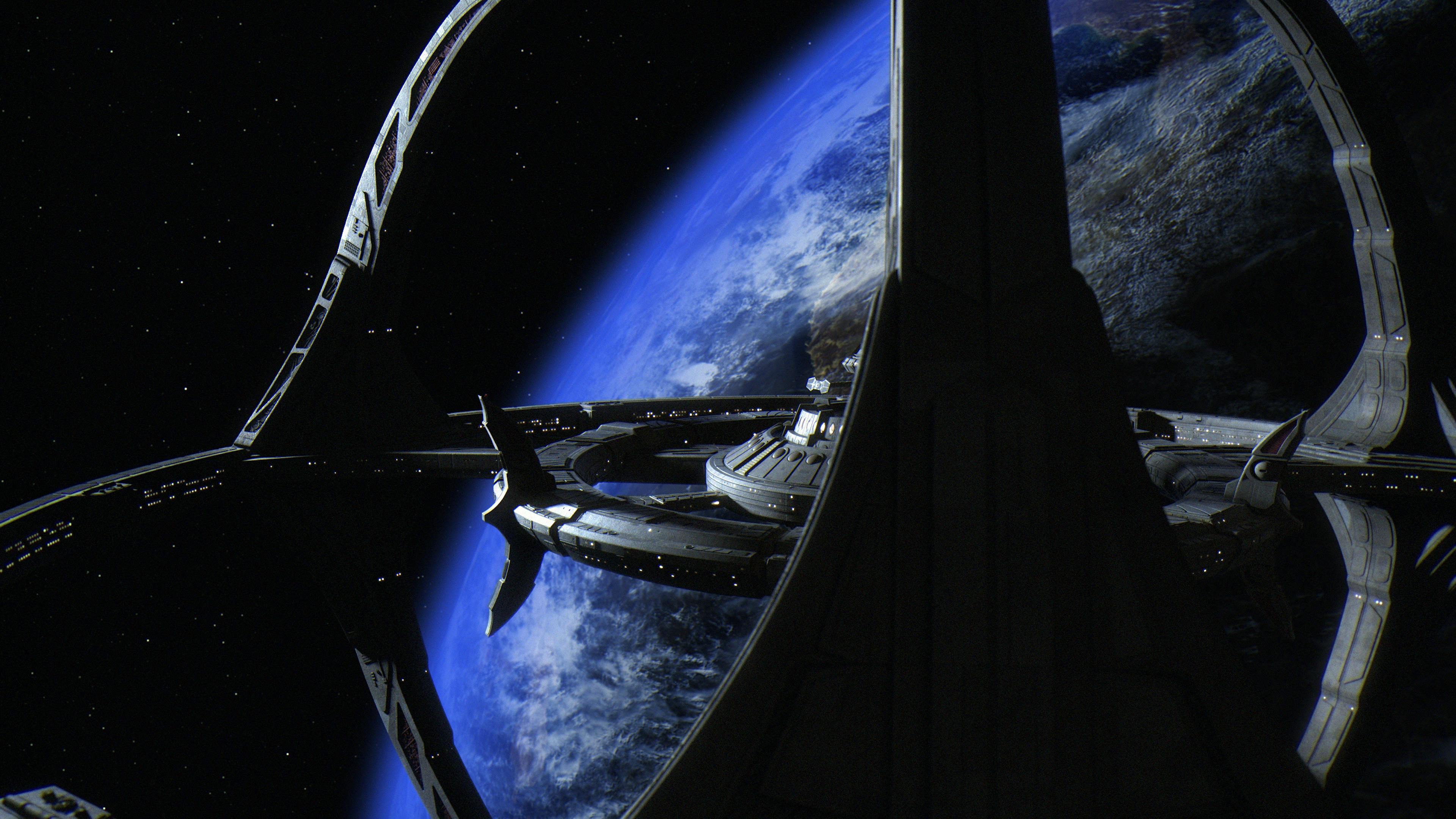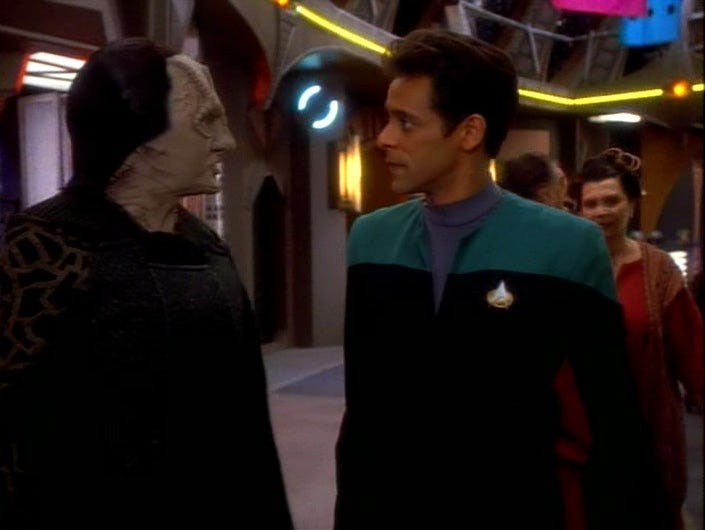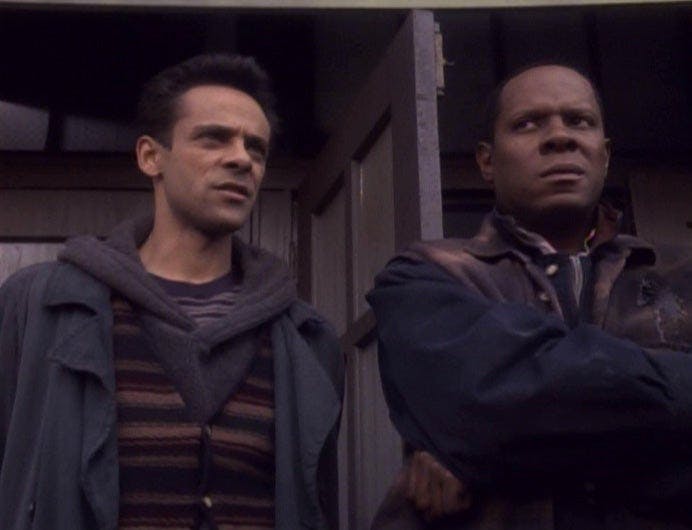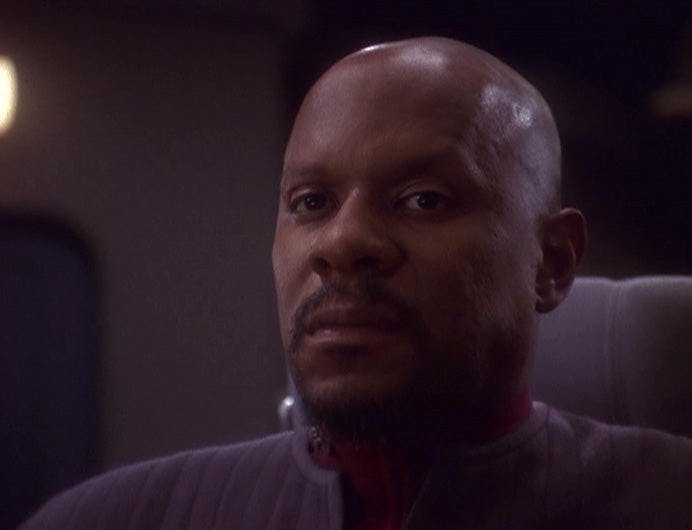Published May 4, 2020
How To Make an Episode of Deep Space Nine
From spec to final script, DS9's Robert Hewitt Wolfe shares how episodes of DS9 came to be.

StarTrek.com
Arguably the most unique part of the 2018 Star Trek: Deep Space Nine documentary, What We Left Behind, was the writer’s room sequence where a select group of original DS9 writers got together, under the guidance of original showrunner, Ira Steven Behr, to break the premiere of a theoretical eighth season of the show. The segment, which intercut footage of the writers brainstorming with animated storyboards, was truly what dreams (at least for us Niners) are made of.
Among those in the room was long-time DS9 scribe: Robert Hewitt Wolfe.
Robert, who’s had an 30-year career writing and producing a range of shows including Gene Roddenberry’s Andromeda, The Dresden Files, The 4400, and most recently Elementary and Prodigal Son, started his Star Trek tenure in 1992 by selling the story that would become fan-favorite TNG episode, “A Fistful of Datas.” He soon found himself a member of the newly created DS9 writer’s room, where he would work through the fifth season. During his time on the show he wrote or co-wrote close to 40 episodes, including such classics as “The Wire,” “Past Tense,” “The Way of the Warrior,” and one of Trek’s best season finales “A Call to Arms.”
I had the pleasure of chatting with Robert recently about his time on Star Trek and what it was like inside the DS9 writer’s room.
StarTrek.com: Let’s go all the way back to your first contact with Star Trek. How did you get in front of the TNG Producers to pitch what eventually became “A Fistful of Datas?”
Robert Hewitt Wolfe: I made my first student film [at UCLA] and it cost me a bunch of money I didn’t have. I then wrote a script and entered a competition. I came in second and won $2,500 bucks – enough to buy my first computer. It also got me an agent. A few years later, my agent ended up representing Joe Menosky who, at the time, was a staff writer on Next Generation.

StarTrek.com
Next Gen had an open-door pitch policy. If you were an established writer, especially if you had an agent who represented one of the other writers on the show, you could send them a sample; it didn’t have to be Star Trek, and if they liked it, you could schedule a meeting. Even if you didn’t have an agent you could just send in a spec script and they would read it; this is incredible to think about now.
I went in the first time to pitch with a couple of ideas I thought were pretty strong. I didn’t sell them but I impressed them enough to be invited back a second time and then a third time. My third time in, I pitched a pretty well-developed idea for a time-travel episode that they liked, but just then they were doing “Time’s Arrow.” Mine was a totally different time period, but they thought they didn’t need another time travel story.
I then pitched them a second thing, which was much less developed: "Worf goes into the holodeck while Data is trying to interface with the ship and suddenly every character in the holodeck is replaced by Data and they all have android super speed and reflexes and Worf has to beat Data in a gun fight." Well the producers thought that was great and they bought it!
They then invited me to write the outline, which they liked enough to let me write the first draft. Then Brannon [Braga] rewrote it because that’s how they did things. After that, they gave me an assignment for Deep Space Nine. They had the basic idea for "Q-Less" but they were having issues with the story and they wanted someone to write the script. I pitched them some changes, which they liked. They then had me write that episode and they liked that enough that then they hired me on to staff.
How old were you got started on Star Trek?
RHW: I was 27. Because of the show’s open-door policy, Michael [Piller] was able to discover a lot of writers. I think he prided himself on finding talent and starting careers; a lot of us owe him. The Star Trek writer’s room was as young as it was because Michael was actively looking for new talent. Star Trek was a special beast and he believed you had to find and train people to write it.
How did an episode of Star Trek go from an idea to as shooting script?
RHW: It all starts with an idea. The open-door policy meant we were hearing pitches three times a week. Sometimes an idea would come out of that or sometimes it would simply come from one of us. Like Ron [Moore] saying, “we should time-travel our characters back to an episode of the Original Series to celebrate the [25th] anniversary.” That was Ron’s idea but we would all then put our heads together.
Once we had the idea, the next step was a meeting with the staff writers to talk about the general shape of the episode. Here’s the idea and here’s the basic form I see the episode taking. What’s the A-story? What’s the B-story? What’s the emotional stuff we want to cover? What’s the theme? What’s the psychological stuff?

StarTrek.com
Then the assigned writer would go write a five to seven-page document, double-spaced, Times New Roman 12 -point, that would be the basic shape of the episode. It was prose. That would then get revised by whoever was the supervising writer and eventually it would get revised by Ira and then we’d get notes from Rick [Berman] until we were all feeling good about it.
The next step was breaking the story. This is a pretty universal television phenomenon. The writers get together in a room, and like you saw in the documentary, you start breaking down the episode. Essentially you work out the structure of the episode. What’s every scene going to be? Who’s in it? What’s the scene about? What does it accomplish? How does it launch us to the next scene? All of that gets nailed down in the room.
Depending on the show, story breaks can take between a few days to a week or two. They can be all day affairs. On Star Trek generally we would get together for three or four hours for two to three days in a row and just break it – we broke things very, very quickly. It was a group effort.
Based on that, the writer of the episode would write an outline for the episode that would flesh out what was up on that board. We didn’t get too deep into the scenes – they were fairly tight outlines, about ten pages long. At the end of the day you’d have almost a first full draft of the episode, without the dialogue. That would also go through the entire approval process. Once that was all approved, then the writer of the episode would go off and write the episode based on the outline.
How much time would the writer then have to write the episode?
RHW: Ideally two weeks; but it was always two weeks with a lot of responsibilities if you were on staff. You’d be writing at home after work because there was a lot of other stuff you had to be doing during the week. Sometimes you had less than two weeks but two weeks was what we tried to give everybody. Even though we did 26 shows a year and there were only five of us, we still somehow managed to give each other two weeks. On most shows you do not get that much time. Most shows I’ve been on you get seven or eight days.
What happened after the writer completed their draft of the script?
RHW: Once the script was written, you gave it to the group, everybody read it and gave comments and then you’d do another draft. If you were a freelancer, that was usually it – whoever was supervising the freelancer would just do a rewrite based on everyone’s notes. Eventually Ira would do a pass and most of the time I’d help him.

StarTrek.com
With so many people contributing to scripts, how were things eventually credited?
RHW: Michael [Piller’s] policy was that he would give writing credit to whoever he thought deserved it. In the first couple of seasons you’ll see a lot of our staff members names on scripts and that means that they were the ones that did the major rewrites or took over the scripts. Once Ira took over, he had a different philosophy. He felt all of our names were already on the show as story editors or producers or what have you, so we stopped putting our names on the shows that we re-wrote.
Did the director or actors have any input on the scripts once they were written?
RHW: Originally Michael and Rick [Berman] signed off on the final scripts, then it was Ira and Rick – and that was what was shot. The actors and directors certainly were able to talk to the writers or to Ira or Rick if they had concerns and then the writers would consider those concerns and make adjustments if we thought the script needed it. On some shows, producers are happy to say "go ahead and improvise; if you don’t like the dialogue just change it." That wasn’t the case on DS9 or the other Star Trek shows because they were so technical and precise. We had to lock down scripts and make sure that everybody was going to say exactly what they were going to say well in advance of production.
When it came to action scenes and special effects, how much would you include in the scripts?
RHW: We wouldn’t call out the exact shots or the angles, but the script certainly called out what we thought the sequence should be. Suddenly the Defiant does this or the Station does that or Garak shoots the guy in the back, he drops – all of that was scripted.

StarTrek.com
From the initial idea to the show being shot and ready for broadcast, how long was that process?
RHW: Somewhere between ten to twelve weeks. You had about four weeks of script work, three weeks of prep and shooting combined, two or three weeks of post-production. If that timeline was compressed, it was compressed on the script side. We couldn’t really change the amount of time it took to prep and shoot an episode. If we were really running behind, the people that had to work faster were the writers.
We did this 26 times a year, but remember that there was a ton of overlap. When one episode was prepping, the previous episode was being shot, when an episode was being shot, the previous episode was being edited. And there were usually three or four scripts in the works at the same time. It was a machine that had to chug along and we as writers had to keep the machine fed.
The show needs pages of script to shoot. If they don’t shoot, it’s a disaster. The amount of money you waste on a day of not shooting, is insane. So that was the job. Keep the machine going.
You contributed a great deal to Star Trek canon and mythology over the years. What specific contributions are you proudest of?
RHW: There’s a few. While it was a group of effort, I put in a lot of work into the Dominion. Who they were and how they were structured – a big chunk of that was me. Also the Ferengi mythology and culture; Ira had a lot of input – and the two of us wrote a book called “Legends of the Ferengi” – but I did a lot of work on the Ferengi. I also contributed to many aspects of Klingon culture, stuff that Ron had begun in his TNG days. Then there was the mirror universe. I am proud of a lot!

StarTrek.com
With hindsight, what are your favorite episodes you wrote?
RHW: People still respond very positively to “The Wire,” which I think is one of the best things I’ve written, certainly on DS9. “Past Tense” continues to be very timely. As a group, we did a lot of great work – TV writing is a team sport, and that was a wonderful team to be a part of.
To wrap things up, what are you working on now?
RHW: I’ve written a Young Adult trilogy, Billy Smith and the Goblins. The first book is called, The Goblin Crown, the second, The Fallen Star, and the final book, The Final Drop, is scheduled to come out this July. They’re aimed at 10-14 year olds and they’re the kind of adventures story I loved as a kid. Hopefully, Star Trek fans will recognize some of the books’ thematic elements and enjoy them!
A big thank you to Robert Hewitt Wolfe for his time and insights. Make sure you follow Robert on Twitter: @writergeekrhw. This interview has been edited and condensed.
Carlos Miranda (he/him) is the CEO of Social Misfits Media, a London-based digital agency. Carlos, as obsessed with coffee as he is sci-fi, loves blogging about Star Trek in his spare time. Follow him on Twitter: @doublemacc.

